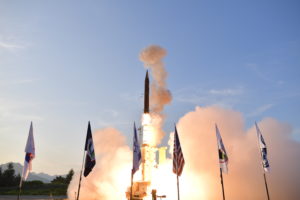An Israeli official this week confirmed the new Arrow-4 missile defense interceptor being developed by Israel and the U.S. aims to be more affordable to allow a higher volume of units.
The Arrow-4 is set to replace the Arrow-2 two-stage interceptor, which is geared to defend against short and medium-range ballistic missiles in the endo and exo-atmosphere realms. It uses an explosive-fragmentation warhead. The Arrow-2 was first deployed in 2000.

“One can ask, okay, why do you go ahead and start with development of Arrow-4? It was a feasibility study that we conducted together with the Missile Defense Agency for almost two years. We came to the conclusion that we need to produce and to have a high volume of this layer, the endo-atmospheric layer,” Moshe Patel, director of the Israel Missile Defense Organization (IMDO), said during a Center for Strategic and International Studies event on May 30.
He added that after IMDO and MDA developed the Arrow-3 system with its newer capabilities they decided those capabilities can and should be adapted to Arrow-4.
Arrow-3 entered service in 2017 with a hit-to-kill warhead targeted at longer-range exo-atmospheric threats in space. Arrow-3 is currently the upper-most layer of Israel’s missile defense systems.
“The new interceptors will be – I’m careful to say, but it will be a little more affordable compared to Arrow-2 or Arrow 3. And it’s a kind of price objective development that we are doing together with MDA,” Patel said.
The Israeli and U.S. governments first announced they are developing the Arrow-4 in early 2021 to ultimately replace the Arrow-2 (Defense Daily, Feb. 18, 2021).
At the time, the countries said cooperative program work would proceed with primary contractor Israel Aerospace Industries (IAI) to defend against threats coming from both inside and outside the Earth’s atmosphere.
Patel noted Arrow-4 is being developed “first of all, producing in high volumes and having better capabilities in the endo-exo layer.”

He added IMDO along with MDA are monitoring Arrow-4 development almost every day to ensure it will perform “according to our price objectives and that it will be performance that we needed.”
The U.S. government helps fund Israel’s missile defense programs and they are under a memorandum of understanding that the DoD provides $500 million per year in funding for Israel’s multi-layered air and missile defense, which continues in the Biden administration’s fiscal year 2024 budget request.
Other Israeli air and missile defense programs the U.S. has helped fund and develop include the Iron Dome, David’s Sling and the Arrow systems.
In 2019, the U.S. and Israel finished a flight test campaign of the Arrow-3 interceptor in Alaska to demonstrate its ability to conduct high altitude hit-to-kill engagement (Defense Daily, July 29, 2019).